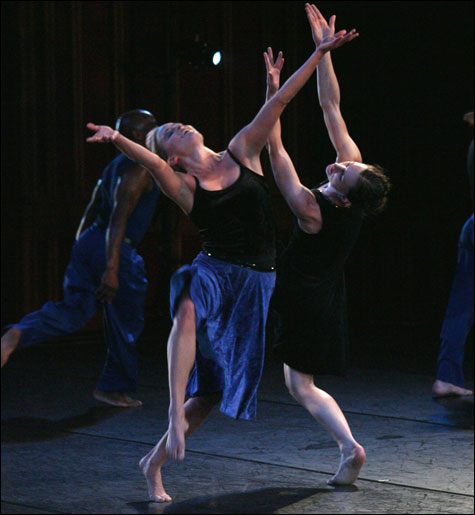
POETS AND CLOWNS MMDG: offers romance with a nose for the absurd. |
Youth, it’s said, is wasted on the young, and that used to be an almost universal truth in the dance world, where dancers could be “retired” by age 26 or so, just when their life — and therefore their art — was beginning to deepen. Now it’s de rigueur for dancers to ripen, as they perform into their upper 30s, 40s, even 50s. Often they can still kick their ears, but who cares, listen to what they’re saying.
Such gravitas enriched the appearance of the Mark Morris Dance Group last week at Tanglewood’s lovely Seiji Ozawa Hall. The program promised a breezy evening of dancers waltzing and viewers sighing to Brahms and Schubert (with a bit of Barber thrown in to keep everyone sharp). Performed one way, it could have been too much waltzing and sighing, too much pretty. Of course, the Morris youngsters have much to offer; the point is that the presence of company veterans infuses MMDG with a maturity that both grounded and lifted this presentation to a higher plane.
Especially telling is the way the company performed the 1989 Love Song Waltzes, which is set to Brahms’s first set of Liebeslieder Walzer. The dancers manage this homage to Romanticism without descending into sentimentality or, worse, winking sarcasm. Morris is known for his humor and his nose for the absurd: where appropriate, he’s the Snarky King, but Love Song Waltzes doesn’t come across like some elaborate joke. The mixture of movement flows from formal (low piqué arabesques, with rounded arms and proudly erect torsos) to silly (the parody of the ballet pirouette preparation, head a-bobbing, arms swinging and changing through positions — shall we turn en dehors or en dedans?) to lush (the gorgeously unapologetic sweep of big, lunging balances and waltz turns). There was an uncanny tautness among the dancers Thursday night.
Whereas that piece strikes a melancholic chord, New Love Song Waltzes, choreographed in 1982, feels like the younger, inexperienced (in mood, not construction) sibling, always picking itself up and dusting itself off with optimism. From Michelle Yard’s opening cartwheels through the sweet conclusion — Yard’s sweeping arms and torso seeming to gather and comfort the community — New Waltzes embodies the world of these crazy kids today, with their friendly but no-strings-attached hook-ups.
Yard shone throughout the program; I’ve found her unctuous in the past, but like the group she seems to have settled into an honest place without giving up her natural joie de vivre. And Amber Darragh is beginning to project without losing her patina of mystery; as the “sandwoman” in the lullaby section of Bedtime, she moved without defensiveness, revealing a lovely quality. Meanwhile, John Heginbotham has always been a wonder at the tricky combination of class clown/poet — the truth-telling jester.
The world premiere on the program, Excursions, set to Samuel Barber’s piano solo of the same name, begins with a hint of the note-for-note choreography that Morris indulges in at times. (Some call it musicality; I can find it tedious.) After a little hip-shaking boogie-woogie, we get another Morris trademark, the canonic passage that ends in slapstick: one by one the six dancers clap a hand onto the neighbor’s shoulder, and then, in the next “round,” on the neighbor’s derriere. The slapstick turns to wit as the dancers flip around so that the audience gets to see the fine handfuls. The timing is perfect, the effect as sly as an arched eyebrow.